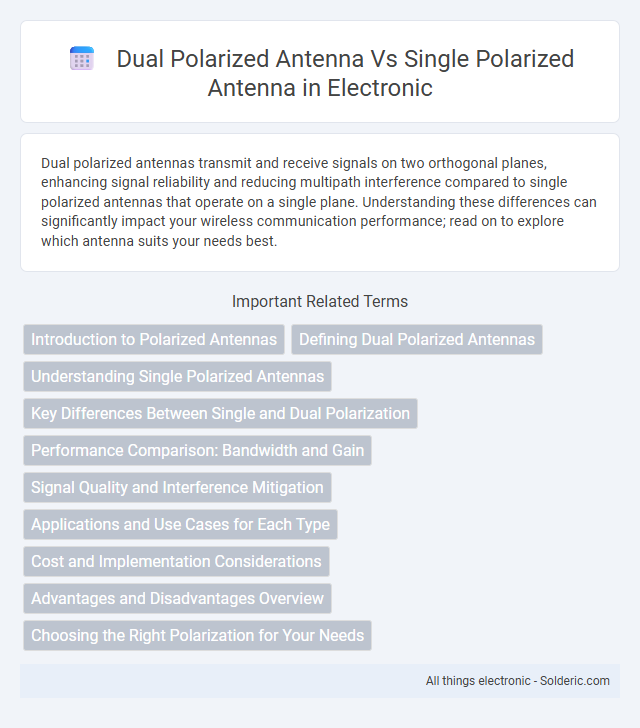Dual polarized antennas transmit and receive signals on two orthogonal planes, enhancing signal reliability and reducing multipath interference compared to single polarized antennas that operate on a single plane. Understanding these differences can significantly impact your wireless communication performance; read on to explore which antenna suits your needs best.
Comparison Table
| Feature | Dual Polarized Antenna | Single Polarized Antenna |
|---|---|---|
| Polarization | Two orthogonal polarizations (horizontal & vertical) | Single polarization (either horizontal or vertical) |
| Signal Diversity | Supports polarization diversity, reduces multipath interference | No polarization diversity, higher multipath impact |
| Capacity | Improves MIMO performance, increases data throughput | Limited MIMO support, lower throughput potential |
| Use Case | Ideal for advanced wireless systems (4G, 5G, Wi-Fi) | Suitable for basic, single-path communication |
| Cost | Higher cost due to complexity | Lower cost and simpler design |
| Installation | Requires precise alignment for best performance | Simple installation with minimal alignment |
| Interference Reduction | Better interference rejection via dual polarization | Less effective at reducing interference |
Introduction to Polarized Antennas
Polarized antennas transmit and receive radio waves with specific orientations of the electromagnetic field, which directly affects signal clarity and strength. Single polarized antennas use one orientation, either vertical or horizontal, making them suitable for simpler communication environments. Dual polarized antennas combine two orthogonal polarizations, improving signal reliability, reducing multipath interference, and enhancing overall performance in complex wireless systems, which benefits your connectivity experience.
Defining Dual Polarized Antennas
Dual polarized antennas transmit and receive electromagnetic waves in two orthogonal polarization planes, typically vertical and horizontal, enhancing signal diversity and reducing multipath interference. This characteristic improves overall system reliability and capacity by supporting multiple input multiple output (MIMO) configurations. In contrast, single polarized antennas operate on a single polarization plane, limiting their ability to mitigate polarization mismatch and signal fading effects.
Understanding Single Polarized Antennas
Single polarized antennas transmit and receive electromagnetic waves with a single plane of polarization, typically vertical or horizontal, which limits their ability to handle signals with varying orientations. These antennas are simpler in design and are commonly used in applications where signal polarization remains consistent. Their performance can degrade in multipath environments or where the signal polarization shifts, reducing overall reliability and signal quality.
Key Differences Between Single and Dual Polarization
Dual polarized antennas transmit and receive signals in two orthogonal planes, significantly improving signal reliability and reducing multipath interference compared to single polarized antennas that operate in only one plane. Dual polarization enhances spectral efficiency and network capacity by supporting multiple data streams simultaneously, while single polarization is simpler but limited in handling diverse signal orientations. Your communication system benefits from increased performance and resilience with dual polarized antennas, especially in environments prone to signal degradation.
Performance Comparison: Bandwidth and Gain
Dual polarized antennas typically offer superior bandwidth performance by supporting two orthogonal polarization planes, which enhances signal reliability and reduces multipath fading compared to single polarized antennas. The gain of dual polarized antennas can be slightly lower per polarization due to combined element design, but overall system gain benefits from polarization diversity and improved signal-to-noise ratio. Your communication system's efficiency improves by selecting dual polarized antennas for environments requiring broad bandwidth and stable gain across varying signal conditions.
Signal Quality and Interference Mitigation
Dual polarized antennas significantly enhance signal quality by transmitting and receiving electromagnetic waves in two orthogonal planes, reducing multipath fading and improving data throughput. They mitigate interference more effectively than single polarized antennas by discriminating signals based on polarization, leading to lower cross-polarization interference and enhanced spatial diversity. This dual polarization capability increases network reliability and overall wireless communication performance in congested environments.
Applications and Use Cases for Each Type
Dual polarized antennas excel in applications requiring improved signal reliability and diversity, such as MIMO systems in 4G/5G networks, Wi-Fi access points, and advanced radar systems, by mitigating multipath fading and enhancing data throughput. Single polarized antennas are ideal for simpler, line-of-sight communication setups like traditional AM/FM broadcasting, point-to-point microwave links, and basic IoT devices where polarization diversity is less critical. Understanding your communication environment and performance needs will help determine whether a dual or single polarized antenna best suits your use case.
Cost and Implementation Considerations
Dual polarized antennas typically incur higher costs due to their complex design and additional components required for supporting two orthogonal polarizations. Implementation can be more challenging, requiring precise alignment and increased space compared to single polarized antennas, which are simpler and cheaper to install. The enhanced performance and diversity benefits of dual polarized antennas often justify their increased expense in applications demanding improved signal reliability.
Advantages and Disadvantages Overview
Dual polarized antennas offer enhanced signal reliability and increased data capacity by transmitting and receiving signals in two orthogonal planes, reducing multipath interference and improving signal quality in wireless communication systems. Single polarized antennas benefit from simpler design and lower cost, making them suitable for applications with less complex propagation environments or where polarization diversity is unnecessary. However, dual polarized antennas tend to be larger and more expensive, requiring more complex installation and maintenance compared to the more straightforward deployment of single polarized antennas.
Choosing the Right Polarization for Your Needs
Dual polarized antennas offer enhanced signal reliability by transmitting and receiving both vertical and horizontal signals, reducing multipath interference compared to single polarized antennas. Single polarized antennas focus on one polarization plane, which may be effective for environments with minimal signal reflection and interference. Choosing the right polarization depends on your specific application and environment, with dual polarization ideal for complex wireless scenarios requiring robust performance.
dual polarized antenna vs single polarized antenna Infographic

 solderic.com
solderic.com